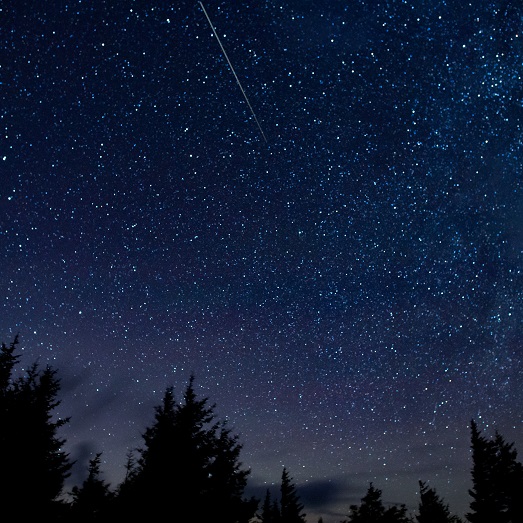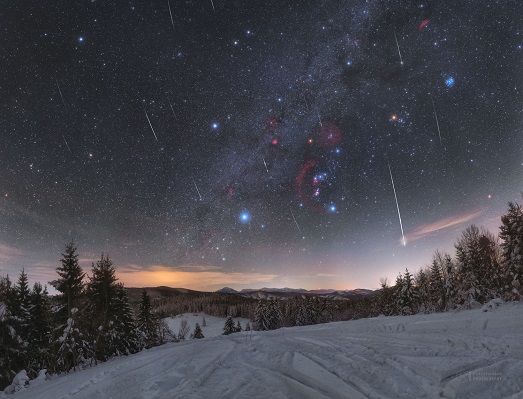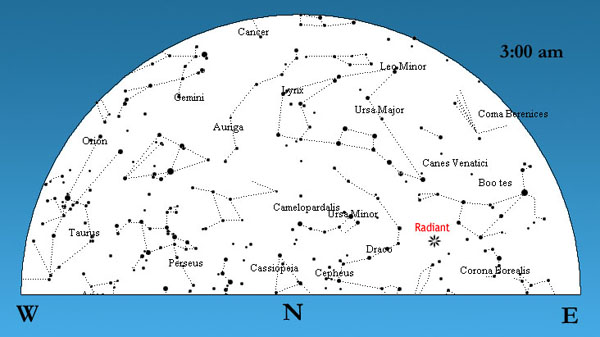 Web Content Display
Web Content Display

Meteor Shower
Tab Menu
 Web Content Display
Web Content Display
Quadrans Muralis (Latin for mural quadrant) is a defunct constellation locating between the constellations of Draco and Boötes. In 1922, the International Astronomical Union (IAU) omitted Quadrans Muralis when it formalised the modern 88 constellations. However, as the word "Quadrantid" had been widely used since the early 19th century, this name was retained when the IAU designed the official name of meteor showers in 2009. This name is still used today when talking about meteor shower.
 Web Content Display
Web Content Display
The peak of the Quadrantid Meteor Shower in 2025 is expected to be at 11 pm on 3 January. The Zenith Hourly Rate (ZHR) of the meteor shower can reach 80. The condition of observation will be favourable as moonlight will not interfere with the event. However, due to other factors such as light pollution from the city, observers in remote areas might see 10 meteors per hour during the peak in fine weather.
In early January, the radiant of the Quadrantid Meteor Shower will rise in the northeast at about 1 am. More meteors should be seen when the radiant is higher above the horizon. The best observation time is at about 4 am to 6 am on 4 January.

Credit: Petr Horálek
Normally, the meteoroids of a meteor shower event are originated from its mother comet. When a comet travels through the Solar System, a large amount of debris is left. When the Earth passes through these debris in space as it orbits around the Sun, a large amount of debris falls into the Earth's atmosphere, forming a meteor shower. Since these debris are from the same origin, all meteors emanate from the same point called the radiant. However, astronomers think that the parent body of Quadrantids is the asteroid 2003EH1, in which it may be a comet in the past. One possible candidate is the comet C/1490 Y1 that observed by the ancients in 1490.
The number of meteor of Quadrantid Meteor Shower is not stable. Its maximum ZHR varies between 60 and 200. Its peak, usually lasts for several hours only, is much shorter comparing to other meteor showers. Both the number and brightness of the meteor are significantly lower before and after the peak. Observers are recommended to watch the Quadrantid Meteor Shower at the night of the predicted peak.

Information about the peak of Quadrantid Meteor Shower 2025:
| Date and time | Zenith Hourly Rate* |
|---|---|
| 11 pm, 3 January | 80 |
* The Zenith Hourly Rate (ZHR) is the extrapolated hourly rate of meteors observable in an extremely dark and wide sky with the radiant located at the zenith. As some meteor showers have very short peak periods, observers sometimes extrapolate the number of meteors observed in ten and a few minutes to an hourly number in proportion. Therefore, the Zenith Hourly Rate cannot be regarded as the actual number of meteors visible in one hour. Yet, it can be used as a meaningful comparison between the activities of different meteor showers. Some meteor showers can be as inactive as having single digit Zenith Hourly Rate. There are "three major meteor showers" (Quadrantid meteor shower, Perseid meteor shower, and Geminid meteor shower), which have the ZHRs reaching 100 or even higher values, and hence worth watching.
(Source: International Meteor Organization)
Here are some tips for watching the Quadrantid Meteor Shower:
- The Quadrantid Meteor Shower is known for its sharp peak, observer should watch within a few hours before or after the peak.
- Observers should wait until the rise of the radiant, which is at 1 am on 4 January, so as to see the meteors that belong to the meteor shower. Meteors occur before the rise of radiant are rare and sporadic.
- Meteors do not necessarily appear near the radiant, and most of the meteors are dim. Observers should choose a site with a large unobstructed view and low light pollution. Staying away from other light sources can help your pupils dilate and increase their sensitivity to light.
- Basically, a telescope is not required as meteors are better observed with the naked eye. You may bring along with you a star-map, a red torch, a deck chair and a sleeping bag or blanket. Please observe stargazing manner and refrain from using excessive light as this will affect other stargazers.
- To photograph meteors, a camera with long-exposure function and a wider angle lens are essential. After focusing on starlight, point the camera to the zenith or the darkest area on the sky and set an appropriate aperture and ISO value (such as F2.8 or lower, ISO 800 or higher, depending on the design of the lens and camera, as well as the nearby environment). Then select the time of exposure based on whether a star tracker is used. In general, a longer exposure gives you a higher chance of capturing unexpected meteors. For long exposure you may consider stepping down the aperture to say, F4 or F8 and ISO value to 400 for better image quality. The star image distortion due to camera shaking can be solved by using a remote control or the self-timer function on the camera.
